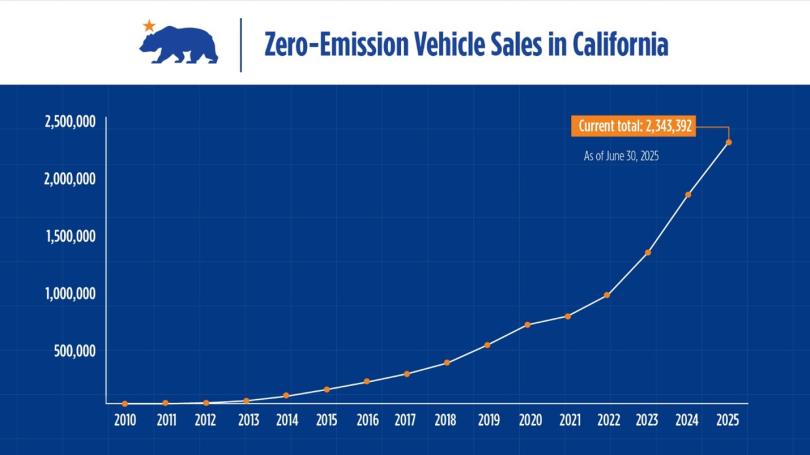For Immediate Release: July 31, 2025
WHAT YOU NEED TO KNOW:
Despite the White House’s targeted attack on zero-emission vehicles (ZEVs), over 100,000 ZEVs were newly registered in California in Q2 of 2025, showcasing Californians’ continued pursuit of zippy, zero-emission cars over polluting gas-powered ones.
SACRAMENTO — In the second quarter of 2025, Californians purchased 100,671 zero-emission vehicles (ZEVs), representing 21.6% of all new vehicle sales in the state. This marks a slight decrease in overall sales year-over-year compared to the second quarter of 2024. Despite numerous setbacks, including tariff whiplash, the dismantling of ZEV incentives, and illegal clawbacks of federal funding for electric vehicle (EV) charging infrastructure, over 100,000 ZEVs were purchased in California in Q2 of 2025, surpassing 2.3 million sales to date. Californians are making it clear: ZEVs are here to stay.
Drivers Continue to Buy ZEVs in California, the Nation, and Worldwide
According to Kelley Blue Book, nationwide EV sales through the first two quarters of 2025 set a record at 607,089, representing a 1.5% year-over-year increase. 27% of new ZEVs sold in the U.S. are sold in California, according to the California Air Resources Board (CARB). Worldwide this year, 25% of vehicle sales are projected to be EVs. Consumers want to drive EVs, and the global move to transition to ZEVs is well underway.
“Despite Trump’s full-on attack, Californians are choosing the clean simplicity of ZEVs. We are saying no to inhaling fumes at gas stations and handling dirty gas nozzles,” said CEC Commissioner Nancy Skinner. “Make no mistake: California is not backing down from its ZEV goals. We will continue to heavily invest in accessible and reliable ZEV infrastructure, making the ZEV driving experience better each day.”
“This quarter’s modest decline in zero-emission vehicle sales is no surprise given the federal government’s misguided and ongoing assault on clean transportation. While they may slow progress, they can’t change the fact that zero-emission vehicles are here to stay — in California and around the world,” said CARB Chair Liane Randolph. “We remain proud of what we have accomplished so far and firmly committed to continuing to do our part to ensure the United States stays competitive in this global market shift.”
The dip in sales, compared with a year ago, continues to be driven by lower Tesla sales, while non-Tesla ZEV sales remain strong and stable.
Federal Incentives End on September 30, 2025
With federal incentives ending on September 30, 2025, the time to buy a ZEV is now. Tax credits up to $7,500 are available for eligible new ZEVs to purchase or lease and up to $4,000 for eligible used ZEVs. Federal incentives for at-home charging and associated energy storage are also available, up to $1,000.
There are currently 150 ZEV models available in California — a 35% increase compared to Q2 of 2024. There’s never been a better time to buy a ZEV. Not only do ZEVs clean the air, but they’re also fun and powerful to drive and cost less to maintain compared to traditional vehicles. Find the right vehicle for you at ElectricForAll.org.
California is the National Leader in Zero-Emission Vehicles and Infrastructure
California’s support for clean cars is unmatched. Despite federal headwinds, California has doubled down on improving the state’s charging network and making it easier than ever to own a ZEV:
- Over 178,000 public or shared private electric vehicle charging ports have been installed throughout California, plus over 700,000 at-home charging ports.
- California has nearly 50% more EV charging ports— public and shared private— than the number of gasoline nozzles.
- 94% of Californians live within 10 minutes of an EV charger.
- Grants and rebates for thousands of dollars are available for low-income Californians to purchase ZEVs. Learn more at ClimateAction.ca.gov or ElectricForAll.org.
Here’s some of what California is doing to make ZEV fueling accessible to all Californians. State agencies are working to speed up EV charger deployment, cut through red tape, plan for the expected increased grid demand, and efficiently electrify charging stations through local utilities. This includes:
- Providing grant funds that support publicly accessible and at-home charging installations, including in multi-family complexes, in communities throughout the state.
- Prioritizing shovel-ready EV charging installations for both state and federal incentives.
- Developing the Zero-Emission Vehicle Infrastructure Plan, a comprehensive plan that lays out the overall infrastructure strategy to meet California’s ZEV goals.
- Establishing charger reliability standards.
California is tearing down barriers to ZEV deployment, spending billions to speed ZEV infrastructure deployment, and deploying infrastructure in hard-to-reach and low-income areas.
###
About the California Energy Commission
The California Energy Commission is the state's primary energy policy and planning agency. It has seven core responsibilities: advancing state energy policy, encouraging energy efficiency, certifying thermal power plants, investing in energy innovation, developing renewable energy, transforming transportation, and preparing for energy emergencies.
Newsroom
Media Contact
Media and Public Communications Office
MediaOffice@energy.ca.gov
(916) 654-4989

